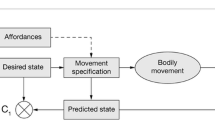Abstract
We consider a general model of the sensorimotor loop of an agent interacting with the world. This formalises Uexküll’s notion of a function-circle. Here, we assume a particular causal structure, mechanistically described in terms of Markov kernels. In this generality, we define two \(\sigma \)-algebras of events in the world that describe two respective perspectives: (1) the perspective of an external observer, (2) the intrinsic perspective of the agent. Not all aspects of the world, seen from the external perspective, are accessible to the agent. This is expressed by the fact that the second \(\sigma \)-algebra is a subalgebra of the first one. We propose the smaller one as formalisation of Uexküll’s Umwelt concept. We show that, under continuity and compactness assumptions, the global dynamics of the world can be simplified without changing the internal process. This simplification can serve as a minimal world model that the system must have in order to be consistent with the internal process.






Similar content being viewed by others
Notes
More precisely, there exists a Souslin topology such that the Borel \(\sigma\)-algebra coincides with the final \(\sigma\)-algebra induced by the canonical projection from \((\mathsf {W}, {\mathcal {W}}_{\kappa })\) onto the quotient.
References
Ay N, Ghazi-Zahedi K (2014) On the causal structure of the sensorimotor loop. In: Prokopenko M (ed) Guided self-organization: inception. Springer, New York
Bauer H (1996) Probability theory. Walter de Gruyter
Bogachev VI (2007) Measure theory, vol I. Springer, New York
Bogachev VI (2007) Measure theory, vol II. Springer, New York
Boylan ES (1971) Equiconvergence of martingales. Ann Math Stat 42:552–559
Karr AF (1975) Weak convergence of a sequence of Markov chains. Z. Wahrscheinlichkeitstheorie verw. Gebiete 33:41–48
Neveu J (1972) Note on the tightness of the metric on the set of complete sub \(\sigma \)-algebras of a probability space. Ann Math Stat 43:1369–1371
Pfante O, Ay N (2015) Operator-theoretic identification of closed sub-systems of dynamical systems. Discontinuity Nonlinearity Complex 1:91–109
Pfeifer R, Bongard J (2007) How the body shapes the way we think. MIT Press, Cambridge
Pfante O, Bertschinger N, Olbrich E, Ay N, Jost J (2014) Comparison between different methods of level identification. Adv Complex Syst 17:1450007
Pearl J (2000) Causality: models. Reasoning and inference. Cambridge University Press, Cambridge
Rogge L (1974) Uniform inequalities for conditional expectations. Ann Prob 2:486–489
Tishby N, Polani D (2010) Information theory of decisions and actions. In: Cutsuridis V, Hussain A, Taylor J (eds) Perception-action cycle: models, architecture and hardware, pp 601–636
Von Uexküll J (1926) Theoretical biology. Harcourt, Brace & Co., New York
Von Uexküll J (1934) A stroll through the worlds of animals and men. In: Lashley K (ed) Instructive behavior. International University Press
Von Uexküll J (2014) Umwelt und Innenwelt der Tiere. In: Mildenberger F, Herrmann B (eds) Klassische Texte der Wissenschaft. Springer, New York
Zahedi K, Ay N, Der R (2010) Higher coordination with less control: a result of information maximization in the sensori-motor loop. Adapt Behav 18:338–355
Acknowledgments
Nihat Ay is grateful for stimulating discussions with Keyan Ghazi-Zahedi and Guido Montúfar. The authors would like to thank Jürgen Jost for his helpful comments.
Author information
Authors and Affiliations
Corresponding author
Appendix: state reduction and quotient construction
Appendix: state reduction and quotient construction
Let \((X, \mathcal {F})\) be a measurable space. The atom of \(\mathcal {F}\) containing \(x\in X\) and the set of atoms of \(\mathcal {F}\) are defined as
Note that if \(\mathcal {F}\) is countably generated, \([x]_{\mathcal {F}}\) is a measurable set, \([x]_{\mathcal {F}}\in \mathcal {F}\). In general, however, \([x]_{\mathcal {F}}\) need not be measurable. We recall Blackwell’s theorem.
Blackwell’s theorem Let X be a Souslin space and \(\mathcal {F}\subseteq \mathfrak {B}(X)\) a countably generated sub- \(\sigma\) -algebra of the Borel \(\sigma\) -algebra. Then
Corollary 11
Let X be a Souslin space, \(\mathcal {F}\subseteq {\mathfrak {B}}(X)\) a countably generated \(\sigma\)-algebra, and \(f: X\rightarrow \mathbb {R}\) measurable. Then f is \(\mathcal {F}\)-measurable if and only if it is constant on the atoms of \(\mathcal {F}\).
According to Blackwell’s theorem, a countably generated sub-\(\sigma\)-algebra of a Souslin space X is uniquely determined by the set of it atoms. \({{\mathrm{At}}}(\mathcal {F})\) is a partition of X into \({\mathfrak {B}}(X)\)-measurable sets. Note, however, that not every partition of X into measurable sets is the set of atoms of a countably generated sub-\(\sigma\)-algebra of \({\mathfrak {B}}(X)\).
Given any measurable space \((X, \mathcal {F})\), we can define the quotient space \(X_\mathcal {F}\) as the set \({{\mathrm{At}}}(\mathcal {F})\) of atoms of \(\mathcal {F}\) equipped with the final \(\sigma\)-algebra \(\mathcal {X}_{\mathcal {F}}\) of the canonical projection \([\,\cdot \,]_{\mathcal {F}}: X\rightarrow {{\mathrm{At}}}(\mathcal {F})\). Then a set \(B\subseteq X_\mathcal {F}\) of atoms is by definition measurable iff \(\bigcup B=\bigcup _{[x]_{\mathcal {F}}\in B} [x]_{\mathcal {F}} \in \mathcal {F}\). Note that, obviously, \(B\mapsto \bigcup B\) is a complete isomorphism of boolean algebras from \(\mathcal {X}_{\mathcal {F}}\) onto \(\mathcal {F}\). The following lemma follows easily from the standard theory of analytic measurable spaces and is one of the reasons why Souslin spaces, rather than Polish spaces, are the “right” class of spaces to work with in our setting.
Lemma 12
Let X be a Souslin space and \(\mathcal {F}\subseteq {\mathfrak {B}}(X)\) a sub-\(\sigma\) -algebra. Then \(\mathcal {X}_{\mathcal {F}}\) is the Borel \(\sigma\)-algebra of some Souslin topology on \(X_\mathcal {F}\) if and only if \(\mathcal {F}\) is countably generated.
Rights and permissions
About this article
Cite this article
Ay, N., Löhr, W. The Umwelt of an embodied agent—a measure-theoretic definition. Theory Biosci. 134, 105–116 (2015). https://doi.org/10.1007/s12064-015-0217-3
Published:
Issue Date:
DOI: https://doi.org/10.1007/s12064-015-0217-3




